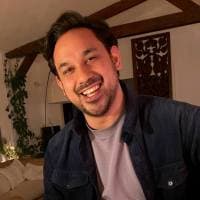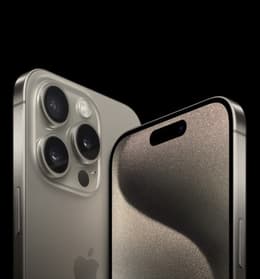
The iPhone 15 was - until recently - the latest series of smartphones from Apple. However, with the recent launch of the iPhone 16, you may be wondering whether it’s worth getting the previous model or splashing out on the latest one. This iPhone 15 review explores the pros and cons of the series and what features you can expect from each model, as well as comparing it to the iPhone 16 series. Make an informed choice with all the facts at your disposal.
iPhone 15

The iPhone 15 series is a worthwhile upgrade on the 14 series.
Bottom line
Rating: 💗💗💗💗🤍
The iPhone 15 series launched in September 2023, with four models available – the base model, the Pro, the Pro Max and the Plus. In September 2024, the Pro and Pro Max models were discontinued in advance of the release of the iPhone 16 Pro and Pro Max. The 15 series offers a variety of enhanced features compared to the 14 series, including a serious camera upgrade. Whereas, the 15 and 16 series are relatively comparable in terms of performance, with just a few subtle upgrades and additional features. So, if you’re thinking of upgrading your iPhone 15 to an iPhone 16, the answer is probably to wait until your current model is a little older. However, if you already have an older model and want to upgrade, the iPhone 15 could be an excellent choice, and certainly more affordable than the 16, particularly if you shop refurbished on Back Market.
iPhone 15 pros and cons
Pros | Cons |
|---|---|
🗹 Great camera upgrade | 🗷 No always-on display |
🗹 Brighter display | 🗷 No improvement in charging speed |
🗹 More comfortable to use and hold | 🗷 More expensive than comparable Androids |
🗹 USB-C port for greater connectivity | 🗷 No autofocus or telephoto camera on ultrawide |
🗹 Solid battery life | |
🗹 Water and shatter-resistant body |
Expect more additional features than the last Apple series upgrade, and a seriously better camera. While the price can be quite high compared to Androids, this is true for all iPhones, not just the 15 series, and Apple users are typically happy to pay a little extra for a brand that delivers what they want. Compared to the iPhone 14 series, this strikes a neat balance between enough innovation to make the upgrade worthwhile, and enough familiarity to make using it comfortable.
Read on to discover why we think the iPhone 15 is a great choice for your 2024 upgrade.
iPhone 15 technical specifications
Any iPhone 15 review worth its salt should start with the technical specifications, so let’s dive in:
Technical specification | Detail |
|---|---|
Storage | 128GB / 256GB / 512GB |
Memory | 6GB |
Screen size | 6.1” |
Display | OLED |
Resolution | 2556 x 1179 pixels |
Screen type | Super retina XDR |
Weight | 171g |
Network | 5G |
Battery life | Up to 20 hours video playback / 80 hours audio playback |
Main camera | 48mp |
Ultra-wide camera | 12mp |
Now let’s have a look at some of the standout features of the series:
Dynamic Island for alerts and in-progress background activity
Haptic Touch to get things done faster
Wide colour (P3)
2000 nits peak brightness
Support for multiple characters and languages on the display simultaneously
Advanced dual camera system
2 x optical zoom
4K video recording
Face ID
Emergency SOS via satellite
Apple Store price (new): From £699.00
Back Market price (refurbished): From £466.00*
iPhone 15 review: models and upgrades
As well as the original iPhone 15, you can also get an iPhone 15 Pro, iPhone 15 Plus, and iPhone 15 Pro Max. But what’s the difference between the different models, and is it worth paying more? Let’s see.
The iPhone 15 Range

A choice of iPhone 15 models
iPhone 15 Pro review
Technical specifications:
Technical specification | Detail |
|---|---|
Storage | 128GB / 256GB / 512GB / 1000GB |
Memory | 8GB |
Screen size | 6.1” |
Display | OLED |
Resolution | 2556 x 1179 pixels |
Screen type | Super retina XDR |
Weight | 187g |
Network | 5G |
Battery life | Up to 23 hours video playback / 75 hours audio playback |
Main camera | 48mp |
Ultra-wide camera | 12mp |
The iPhone 15 Pro has most of the same features as the base model, but with a few extras that could be worth the additional cost, depending on what you use your phone for the most. If you’re drawn to the iPhone 15 because of the superb camera, then the Pro brings a few more additions to the table. Not only is the main camera a whopping 48mp, but you can also get 24mp picture quality 1.2x and 1.5x zoom. Plus, there’s an extra third rear camera with a 3x telephoto lens, and you can opt for as much as a terabyte of storage – ideal if you like to snap multiple pictures and videos. It also has a higher refresh rate and a swifter A17 chip, plus a customisable action button.
Apple Store price (new) upon release: From £999.00
Back Market price (refurbished): From £568.78*
iPhone 15 Plus review
Technical specifications:
Technical specification | Detail |
|---|---|
Storage | 128GB / 256GB / 512GB |
Memory | 6GB |
Screen size | 6.7” |
Display | OLED |
Resolution | 2796 x 1920 pixels |
Screen type | Super retina XDR |
Weight | 201g |
Network | 5G |
Battery life | Up to 20 hours video playback / 100 hours audio playback |
Main camera | 48mp |
Ultra-wide camera | 12mp |
The iPhone 15 Plus in many ways is essentially just a bigger version of the iPhone 15. That said, this results in longer battery life and a higher screen resolution. If you’re often on the go and worried about recharging, the Plus can comfortably stay switched on for around two full days, provided you’re not streaming video.
Apple Store price (new) upon release: From £899.00
Back Market price (refurbished): From £464.00*
iPhone 15 Pro Max review
Technical specifications:
Technical specification | Detail |
|---|---|
Storage | 256GB / 512GB / 1000GB |
Memory | 8GB |
Screen size | 6.7” |
Display | OLED |
Resolution | 2796 x 1920 pixels |
Screen type | Super retina XDR |
Weight | 221g |
Network | 5G |
Battery life | Up to 29 hours video playback / 95 hours audio playback |
Main camera | 48mp |
Ultra-wide camera | 12mp |
The iPhone 15 Pro Max has a number of additional features that make it stand out from the base model. These include a larger 120Hz screen, a telephoto lens, and an Action button. The additional camera has a periscope design which allows for 5x optical zoom – a far longer distance than the base model, the Pro and the Plus. It is also equipped with the latest A17 chip set for faster processing, alongside an extra 2GB of RAM. If you use your phone for gaming, the Pro Max is probably your best choice in the iPhone 15 series.
Apple Store price (new) upon release: From £1,199.00
Back Market price (refurbished): From £672.06*
What’s the difference between the iPhone 15 and the iPhone 16?
The iPhone 16 is the latest smartphone release from Apple, launched in September 2024. Compared to the iPhone 15, you can expect improved battery life, a faster chip, additional camera control features and Apple Intelligence support. However, these improvements come at a price – the iPhone 16 is currently priced at around £799.99 new, whereas the iPhone 15 retails for around £699.99.
If you shop at Back Market, you can save even more on a refurbished iPhone 15, with prices starting at just £486.17 for the 128GB model. This comes complete with a 30-day money-back guarantee and a warranty for a minimum of a year, giving you complete peace of mind, as well as saving you money.
The verdict
As shown in this iPhone 15 review, if you need to upgrade from an older model, the 15 series is a good bet. While the 16 series does have a few added extras, you’re looking at a minimum price hike of £100, and that’s if you buy new. The iPhone 15 Pro Max is just as good as, if not even better than, the iPhone 16 base model, while the iPhone 15 base model is a vast improvement on the 14 series. If you want to save even more, and you don’t need all the latest features, you could even shop for a slightly older model or an Android phone.
Best Back Market prices
For a nifty smartphone that does everything you need, without a hefty price tag, try shopping for slightly older refurbished models on Back Market.
Make / Model | RRP | Back Market starting price |
|---|---|---|
£479.99 (eBay) | £302.69* | |
Apple iPhone 13 Pro | £484.99 (eBay) | £319.12* |
Samsung Galaxy S23 | £400.00 (Amazon) | £367.68* |
£364.99 (eBay | £288.48* |
*Prices displayed are based on date of publication - prices are subject to change.















